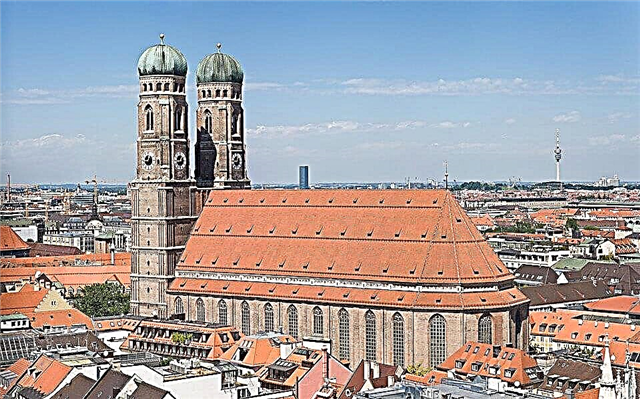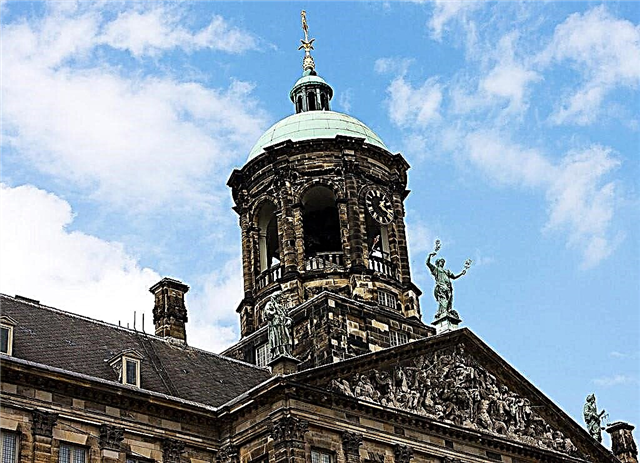The Royal Palace is one of the most visited and popular places not only in Amsterdam, but throughout the Netherlands. The palace is located in the very center of the capital, not far from the main railway station, on the most important and famous square of the city, Dam Square.

How to get from the airport to the center of Amsterdam - read our article.
The largest secular building in Europe
Dam Square gets its name from a dam that was built on the Amstel River in the 13th century. It was formed from two areas - Platse and Middeldam. On both sides of the palace is the Nieuwequerque church, built in the 15th century and the world famous Madame Tussauds wax museum. The palace was originally built as the main building for the city hall, as well as for administrative and court sessions.
In the 17th century, it was the largest secular building in Europe. At the moment, the palace is used as a residence for receiving foreign delegations and heads of foreign states during their visits to the Netherlands, the royal family itself does not live here. In addition, ceremonies for the transfer of the throne and weddings of the monarchs of the Kingdom of the Netherlands are held. The Royal Palace at Dam Square is, according to the law of the Dutch Parliament, one of several palaces in the possession of Queen Beatrix.
Read what else to see in Amsterdam in our life hack.

Construction history
The building was designed by the architect Jacob Van Kampen in 1665 on 13 659 piles made of wood, each of which is up to 12 meters long. He was faced with the daunting task of building a royal palace in one of the most influential countries of the time. Amsterdam was one of the largest shopping centers in Europe in the 17th century.
More useful and interesting articles about Amsterdam:
- How to get from Amsterdam to Bruges
- How to get to Amsterdam on your own
- Amsterdam museums
- How to get from Paris to Amsterdam
- NEMO Museum in Amsterdam
- How to get from Brussels to Amsterdam
The population of the city was constantly increasing, and trade and economic ties expanded more and more. That is why the architect Jacob Van Kampen expressed the idea of constructing a building in the style of classicism, so that it would reflect the power of the whole country, and in appearance would resemble the architectural structures of Ancient Greece and Rome. As a consequence, the style in which the palace was built began to bear the name of the style of classical Dutch architecture, and the palace, in turn, is its main example. It was intended to show how powerful and wealthy the city of Amsterdam was during the Golden Age.

The eighth wonder of the world
The Royal Palace in Amsterdam is often referred to as the eighth wonder of the world. It was literally built on a swamp, and is supported by numerous piles and a platform standing on them. The walls of the palace were erected directly on the platform, which was considered unusual and new at that time. Inside the palace there is a huge spacious hall (Civic Hall) almost 27 meters high, 37 meters long and 19 meters wide, which symbolizes space. On the floor of the hall there are maps of the world depicting celestial spheres. They were painted in the 18th century and are easily visible on the Western and Eastern Hemispheres, where the places of the successful colonial policy of Amsterdam are marked in detail.

Near one of the walls is a sculpture of the mythological titan Atlanta, who holds the globe on his shoulders. The main decoration of the palace is its huge dome. At the very top of the dome is a weather vane in the shape of an old cogg ship, the symbol of the city of Amsterdam. Through its small windows, people used to watch which ships came and went from the city port. All premises of the building are marble and gilded. One of the most famous Dutch poets, Jost Van den Vondel, perhaps managed to describe the pride of the inhabitants of Amsterdam with surprising accuracy when he called the palace building "the bride who is in the spotlight on her wedding day."

First Town Hall
In 1400, the first town hall was built in a small settlement called Amsterdam on the square that is today called Dam Square. In 1452, the town hall was destroyed by a big fire, and then rebuilt again, but with a special place reserved for court cases. From here the chief judge of the city performed his affairs. In 1652 there was another fire. This time the building remained abandoned for a while. Someone or something constantly interfered with the construction of a new building on the site of the old one.
The city hall was going to demolish residential buildings in the city center to build a palace, but local residents were strongly against this. When the issue with the civilians was nevertheless resolved, it turned out that because of the war with Spain there was no money in the country, and construction was impossible. A few years later, it was decided to build an administrative building on the same site, but several times larger.

The government of the country has long been arguing about the budget and the size of the future town hall. In the end, the town hall was built in the style of strictly classicism and bright colors. In addition, in the planning and construction of the building, numerous allegories and references to deep philosophical ideas were used. This is what helped to carry out the project of the town hall. Since the majority did not want to spend large sums of money on the interior decoration of the town hall and decorations, however, the supporters of the project said that all decorations, reliefs and paintings are designed to show people the decoration of the world. As a result, they agreed with this idea, and the town hall was built according to the ideas and proportions that were used by God in the creation of the world.
For several years, the Town Hall was considered the largest town hall in all of Europe. When the brother of Napoleon Bonaparte, Louis Bonaparte, came to power at the beginning of the 19th century, he made a personal residence out of the town hall, and since then the building has been considered a palace. Louis Bonaparte was 27 years old when he arrived in a poor and devastated country like Holland at the time. Even though the elder brother forbade all trade with England, which he wanted to completely isolate from the rest of Europe, Louis still allowed the inhabitants of the Netherlands to trade with them.

Especially for the arrival of Louis Bonaparte, the entire government was evicted from the town hall, but the bank had to be left, given the not very favorable situation in the country at that time. In fact, this is the only moment in history when the bank was located directly in the building of the royal palace. Also, especially for Louis, a unique collection of furniture made in the Empire style was ordered to the palace, including wooden chairs covered with expensive fabrics, brass lamps and tapestries.
All this can still be seen by visiting the palace. In 1813, at that time, still the future King William, handed over the royal palace to the city. Nevertheless, shortly after the coronation, he realized that he still needed his own residence in the city. Therefore, the city government, at his request, nevertheless gave the former town hall at the disposal of the king. In 1936, the former town hall was sold by the Amsterdam City Hall to the Dutch government.

After long discussions, the city government nevertheless admitted that the building was no longer suitable for the role of the town hall of the capital of the Netherlands, and besides, the building needed a very serious restoration in order to restore it to its former beauty and grandeur. In 1938, the building was the site of a ceremony to commemorate the 40th anniversary of Queen Wilhelmina's reign.
[tp_calendar_widget origin = MOW destination = AMS responsive = true subid = ”korolevsiydvorecamster”]
Reconstruction of the palace
In 2009, a large-scale reconstruction was carried out in the palace and the palace was opened to the general public. By visiting the museum located in the palace, you can get acquainted with the history of Amsterdam and the Netherlands. In addition, there is a huge collection of works by Rembrandt, Flink and Bol. The ideal time to visit the palace is in summer and autumn, when numerous exhibitions take place here. In the summer, it exhibits works from the Golden Age on the history of the building. In autumn, the works of young talented artists are exhibited here, and a competition for the Royal Prize in the field of contemporary painting is held.
Not sure what to bring from Amsterdam? Read our review.











